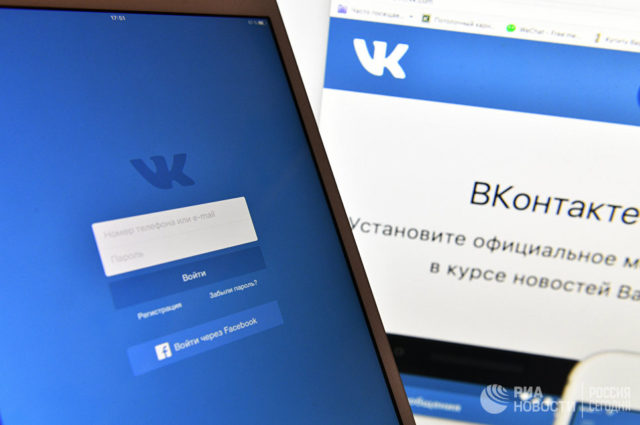
Russian Defense Ministry to Use Social Networks to Select Soldiers
Publication: Eurasia Daily Monitor Volume: 15 Issue: 42
By:

Despite having banned its contract soldiers (kontraktniki) from using online social networks (VKontakte and Odnoklassniki, in particular) (see EDM, October 20, 2017), the Russian Ministry of Defense has not dismissed the idea of using social networks for its own purposes. These policies are driven both by the skyrocketing popularity of social networks (and growing number of Internet users) in Russia as well as the increasing role of military psychology within Russian military strategy (see EDM, March 14, 2018). Additionally, the defense ministry is presently reconsidering the concept of “information” as outlined in the Russian Doctrine on Information Security.
On January 16, the Russian market-research firm GfK presented a report that provided essential data on the spread of Internet use in Russia (Gfk.com, January 16). According to this analysis, in the beginning of 2018, the number of Internet users among Russian adults (16 years of age and above) reached 87 million—a 3 million increase in comparison with the previous year. In his comment, Sergey Ketov, the head of the GfK research branch, pointed out that for the past two years, the number of people using mobile devices has grown by 36 percent. The most important detail in the analysis concerns the segment of young Internet users. The report states that approximately 98 percent of young Russians have near-to-regular access to the Internet. Experts suggest this demonstrates that the percentage of young Russians regularly using the Internet has reached its absolute maximum in Russian history (the trend became particularly visible after 2014).
This impressive growth is related to the rising number of users who employ smartphones (currently, 51.5 percent of adult Russians utilize such devices) to maintain regular Internet access (Gfk.com, January 16). At the same time, another aspect should not be omitted: the growing popularity of online social networks in Russia.
According to available information, in 2017 the daily audience of the most popular network, VKontakte—banned in some countries for its alleged ties to the Russian Federal Security Service (FSB) and for spreading pirated content (see EDM, June 7, 2017)—was approximately 70 million people (Vkhelpnik.com, accessed March 17, 2018). Other networks that enjoy popularity in Russia include Facebook, Odnoklassniki, Instagram and Twitter (Zonkservice.ru, accessed March 18). This suggests that the number of young Russians accessing various social networks on a day-to-day basis (and spending their free time on registered accounts) has grown exponentially.
In this regard, the Russian Ministry of Defense has notably implemented a program that aims to trace the activities of incoming soldiers (mainly draftees) on various online social networks. Specifically, Russian military psychologists will be tasked with assessing the online activities of future soldiers. Reportedly, this will become one of several “projective” screening methods (proyektivny metodiki)—also including individual conversations and detailed analysis of personal characteristics—that are to deliver exhaustive information about the draftees’ psychological profile. Sources also claim that this method will help to ascertain personal motivations, responsiveness to stress, social behavior and mode of action under rapidly changing circumstances. This is to enable specialists to construct all-encompassing psychological portraits for incoming soldiers and come up with specific recommendations for junior officers on how best to work with the new conscripts (Rossaprimavera.ru, January 9).
The experiment was first tried in the Russian Far East (Mil.ru, January 9), a distant region that, since 2014, has become one of the main places where Russia’s Armed Forces routinely test out various innovative military techniques. In particular, the multifaceted psychological profile–building experiment was first conducted in the Amur, the Jewish Autonomous Oblast and Khabarovsk Krai. The defense ministry noted that, in accordance with the results obtained by military psychologists and sociologists, 98 percent of soldiers (23,000 draftees were analyzed) “are entering the Russian Armed forces with joy and great pleasure” (Mil.ru, January 14). Of course, such cited data should be approached with a good deal of skepticism. The legacy of the Soviet experience and established patterns of official reporting, especially in the domain of propaganda, quickly come to mind, after all. However, there is every reason to believe that the general perception of the Armed Forces among the predominant proportion of young Russians has undergone a profound transformation in recent years and is no longer associated primarily with hazing and a lack of order (akin to the 1990s and the early 2000s).
In many ways, this change of perception was prompted by skillful propaganda employed by the Russian Ministry of Defense. Namely, demonstrations of Russian military might in the course of large-scale military exercises, regional conflicts (like the “Five Day War” with Georgia) and especially Russian military involvement in the Syrian civil war played a decisive role in shifting popular attitudes.
Another essential element must not be ignored: the Russian military has realized the growing importance of online social networks (and professionally made video clips) as a powerful means of propaganda. For instance, during the Vostok 2014 strategic military exercises, the Russian defense ministry posted video clips and updates to Facebook, Twitter, Instagram and YouTube in order to demonstrate Russia’s immense military potential (Sovsekretno.ru, September 30, 2014). Interestingly enough, aside from weapons and simulated battlefield maneuvers, the defense ministry’s posted messages regularly featured examples of “military routine,” such as social and joint cultural events. The inclusion of Twitter and Instagram in 2014 (at the time not yet particularly popular among Russian Internet users) as well as YouTube was done primarily to attract international attention and demonstrate the new image of the Russian Armed Forces to other countries.
Turbulent developments in the Middle East (foremost the “Arab Spring”) have demonstrated that online social networks could become more dangerous to ruling regimes than conventional weapons. Increasingly, tapping this resource will provide Russia’s defense ministry with the ability to analyze its incoming human material, attract more soldiers and popularize military service, as well as tackle public perceptions of the Armed Forces.



